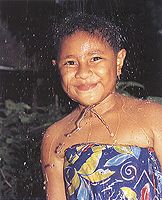 Fiji,
the place makes an indelible impression on those of us lucky enough to
have lived there. Part of the joy is in the warmth of the people. Revisit
after several year's absence and chances are that you will be remembered...
that's special.
Fiji,
the place makes an indelible impression on those of us lucky enough to
have lived there. Part of the joy is in the warmth of the people. Revisit
after several year's absence and chances are that you will be remembered...
that's special.
 Fiji,
the place makes an indelible impression on those of us lucky enough to
have lived there. Part of the joy is in the warmth of the people. Revisit
after several year's absence and chances are that you will be remembered...
that's special.
Fiji,
the place makes an indelible impression on those of us lucky enough to
have lived there. Part of the joy is in the warmth of the people. Revisit
after several year's absence and chances are that you will be remembered...
that's special.
Fiji is a nation of some 320 islands, situated in the tropics. It is north of New Zealand and east of Australia so is readily accessible. The international airport at Nadi on the main island, Viti Levu, handles five Air New Zealand flights from Singapore each week. The whole island group caters for diving but even so there are some areas which are better than others. The Beqa Lagoon, south of Viti Levu, is one such site and is internationally renowned, particularly for its sea fans and soft corals. If you want to savour the delights Beqa has to offer and you like the idea of a dedicated dive resort, there is Marlin Bay Resort, the only dive establishment on the island.
I well remember my first dive with the resort. At the limits of my vision, an underwater pinnacle emerged from the depths and strained towards the surface. It looked deceptively close but it took two or three minutes of finning to reach it. A flash of silver attracted my attention, followed by another and another until my entire horizon was blocked out. The huge school of trevally didn't stay around to investigate us. We must have looked too much like predators. For one brief heart-stopping moment the sea was filigreed silver, with occasional flashes of blue penetrating this giant fish mobile.
Looking back towards the boat Harmony brought home just how good the visibility was. We could see our other divers spread out in line astern. It was hard to judge the visibility and divers are bigger liars about visibility than fishermen are about their catches. I decided that the furthest diver was at least 60 metres away and clearly visible, so draw your own conclusions! We circled the pinnacle hoping the trevally would come back. Who needed trevally? The pinnacle was host to a squadron of Moorish idols. Uncharacteristically these decided to stay in a tight school while my buddy recorded them for posterity.
After the dive the big white dive boat skimmed across the azure water, cooling us with the breeze it created. I looked at our group of satiated divers and pondered the boat's name... Harmony. If ever a dive boat was properly named, it was this one.
The mood on Harmony was infectious. Every now and then someone's face broke into a spontaneous smile. You didn't need to ask why. You knew they were recalling some instant of that magic dive. It was a day when it was gloriously good to be alive and you revelled in the shared experience of something special. That something special was mostly due to the dive resort that made this all possible. Started by American George Taylor in early 1989, the first six bures (accommodation units) of Marlin Bay Resort, and its main dining and entertainment areas were finished in time for the opening in June 1991. Since then, six more bures have been added. The dining area is built in traditional Fijian style with the huge vaulting thatched roof characteristic of Fijian temples. Bures (villas really) have views looking out over a pristine beach, and a handy hammock is available for those who require it.
Fishing is the other raison d'être of the resort. The Beqa area is renowned for big game fishing and Marlin Bay is well named. As is increasingly the case in Fiji, big fish are released and smaller ones are eaten. This explains the almost constant supply of fresh fish that forms the centrepiece of many of the chef's culinary delights.
Beqa is a fascinating island, home to the legendary firewalkers. The legend itself is quite involved but essentially someone out eeling caught a veli or spirit. In return for having its life spared, the spirit bestowed on the Sawau people of Beqa the ability to walk on hot rocks. Even more splendid presents, such as the gift of roasting in an underground oven for days, were offered but turned down .
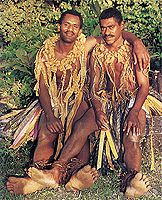 As
the day drifts towards early evening the lali (Fijian drum) sounds
again. Guests assemble in front of the huge pile of burning ashes. Hot
rocks emerge like coral bommies in the lagoon. The Dakuibeqa firewalking
group is here to display their gift. Under the watchful eye of the bete
(master of ceremonies), the troupe removes burning logs. A long tree fern,
said to contain the God, is laid in the direction of the bete. Workers
with vines and poles level the stones until the bete is satisfied.
As
the day drifts towards early evening the lali (Fijian drum) sounds
again. Guests assemble in front of the huge pile of burning ashes. Hot
rocks emerge like coral bommies in the lagoon. The Dakuibeqa firewalking
group is here to display their gift. Under the watchful eye of the bete
(master of ceremonies), the troupe removes burning logs. A long tree fern,
said to contain the God, is laid in the direction of the bete. Workers
with vines and poles level the stones until the bete is satisfied.
 He
takes the first exploratory steps. The crowd hushes, the tension mounts.
A few last minute adjustments to the stones and the tree fern, before the
bete is completely happy. The bete shouts vuto-o and the walkers
appear. The helpers remove the tree fern and the firewalkers step briskly
over the hot rocks. I start to think that anyone can do this. At this point
one of the walkers stops dead in his tracks and stands there smiling at
the onlookers. I expect to hear his feet sizzle and to see smoke rise.
Nothing happens, he smiles again and ambles off. The ceremony finishes
with bundles of leaves spread over the stones. Again the walkers put themselves
in jeopardy. This time, steam and smoke rise all around them.
He
takes the first exploratory steps. The crowd hushes, the tension mounts.
A few last minute adjustments to the stones and the tree fern, before the
bete is completely happy. The bete shouts vuto-o and the walkers
appear. The helpers remove the tree fern and the firewalkers step briskly
over the hot rocks. I start to think that anyone can do this. At this point
one of the walkers stops dead in his tracks and stands there smiling at
the onlookers. I expect to hear his feet sizzle and to see smoke rise.
Nothing happens, he smiles again and ambles off. The ceremony finishes
with bundles of leaves spread over the stones. Again the walkers put themselves
in jeopardy. This time, steam and smoke rise all around them.
I am skeptical and search for a rational explanation. I catch one of the walkers and photograph his feet, which are sooty but otherwise untouched. My scientific training tells me that there is a rational explanation and anyone can do it. My primitive brain, my survival instinct, tells me to shy away.
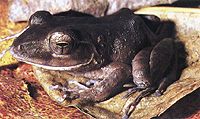 Beqa
is a delight, as much of its native fauna remains intact. There are red-breasted
musk parrots, collared lories, many coloured fruit doves and numerous other
species. My favourite Fijian animal, the rare and endangered Fiji ground
frog, is also found here. Alas, I lack the time to take one of the bush
walks into the centre of the island. There are too many dive sites to visit.
The best of it is that they are all shallower than 30 metres. Carpet Cove,
a large bommie rising from 20m, and already a great site, has been enhanced
by the addition of a 30m longline fishing boat, so you can wreck dive as
well. My favourite is probably ET, which features a number of swim throughs
and fabulous soft corals, sea fans and wire corals. For good measure there
are several leafnosed moray eels. The juveniles are black, turning into
blue and yellow males before the final transition to yellow females. Marlin
Bay provides two boat dives per day but there is unlimited shore diving
for those who are interested.
Beqa
is a delight, as much of its native fauna remains intact. There are red-breasted
musk parrots, collared lories, many coloured fruit doves and numerous other
species. My favourite Fijian animal, the rare and endangered Fiji ground
frog, is also found here. Alas, I lack the time to take one of the bush
walks into the centre of the island. There are too many dive sites to visit.
The best of it is that they are all shallower than 30 metres. Carpet Cove,
a large bommie rising from 20m, and already a great site, has been enhanced
by the addition of a 30m longline fishing boat, so you can wreck dive as
well. My favourite is probably ET, which features a number of swim throughs
and fabulous soft corals, sea fans and wire corals. For good measure there
are several leafnosed moray eels. The juveniles are black, turning into
blue and yellow males before the final transition to yellow females. Marlin
Bay provides two boat dives per day but there is unlimited shore diving
for those who are interested.
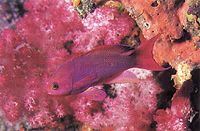 I
leave the resort with great sadness but with superb memories of great diving.
Memories of carpet cove, seven sisters, soft coral plateau, glory hole
and million dollar point. Memories of fiery sunsets over Viti Levu, friendly
Fijian staff, crazy firewalkers, fellow guests with similar interests.
Beqa lagoon was voted one of the world's top ten dive destinations in a
recent dive magazine survey. Now I know why.
I
leave the resort with great sadness but with superb memories of great diving.
Memories of carpet cove, seven sisters, soft coral plateau, glory hole
and million dollar point. Memories of fiery sunsets over Viti Levu, friendly
Fijian staff, crazy firewalkers, fellow guests with similar interests.
Beqa lagoon was voted one of the world's top ten dive destinations in a
recent dive magazine survey. Now I know why.
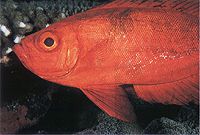 I
am back in the dive skiff after an exhilarating drop off dive. My dive
buddy and I are slightly disappointed. After all Melané had done
a manta mantra but despite her best efforts I still haven't seen one in
over 300 tropical dives. In the distance I see a thin black tendril break
the surface. False alarm, it's the tail streamers of a big school of spawning
black tang. There it is again. This time there is no mistake, it is a manta.
We waste no time in dropping over the side again in snorkel gear. It swims
right up to us, detects our presence then disappears at high speed. No
matter, my day is complete.
I
am back in the dive skiff after an exhilarating drop off dive. My dive
buddy and I are slightly disappointed. After all Melané had done
a manta mantra but despite her best efforts I still haven't seen one in
over 300 tropical dives. In the distance I see a thin black tendril break
the surface. False alarm, it's the tail streamers of a big school of spawning
black tang. There it is again. This time there is no mistake, it is a manta.
We waste no time in dropping over the side again in snorkel gear. It swims
right up to us, detects our presence then disappears at high speed. No
matter, my day is complete.
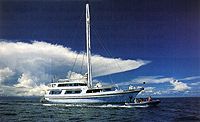 We
are anchored off the island of Wakaya on board the 36m Nai'a, Fiji's biggest
and most luxurious live aboard. Glowing Fijian hardwoods grace the main
salon and there is wood paneling in all the cabins. Cabin is almost a misnomer,
as they boast a genuine queen sized bed as well as shower and toilet facilities.
Each cabin is individually climate controlled by a powerful and efficient
chilled water air conditioning unit which services the whole ship.
We
are anchored off the island of Wakaya on board the 36m Nai'a, Fiji's biggest
and most luxurious live aboard. Glowing Fijian hardwoods grace the main
salon and there is wood paneling in all the cabins. Cabin is almost a misnomer,
as they boast a genuine queen sized bed as well as shower and toilet facilities.
Each cabin is individually climate controlled by a powerful and efficient
chilled water air conditioning unit which services the whole ship.
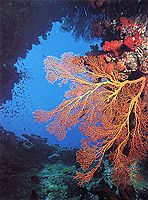 Nai'a
Cruises visit the "off the beaten track" dive sites. They concentrate on
the Koro Sea, that area of water between the three I biggest Fijian islands.
She usually sails at night so that divers can do a dive straight after
breakfast. The boat has been designed for divers. There is a large camera
room with heaps of bench space and lots of power points for strobe recharging.
Even with two professional photographers and a number of amateurs, there
was room for everybody. Just outside are two large freshwater tanks for
washing equipment. Gear is stowed in plastic baskets under benches in the
area immediately aft. Here too is plenty of hangar space to dry wetsuits.
Nai'a
Cruises visit the "off the beaten track" dive sites. They concentrate on
the Koro Sea, that area of water between the three I biggest Fijian islands.
She usually sails at night so that divers can do a dive straight after
breakfast. The boat has been designed for divers. There is a large camera
room with heaps of bench space and lots of power points for strobe recharging.
Even with two professional photographers and a number of amateurs, there
was room for everybody. Just outside are two large freshwater tanks for
washing equipment. Gear is stowed in plastic baskets under benches in the
area immediately aft. Here too is plenty of hangar space to dry wetsuits.
Dive drill is straight forward. The dive guides give a comprehensive review of the site and draw the important features on a blackboard. You then pick up your mask and fins, walk to the stern of the boat and board your dive skiff. The skiffs don't anchor at any site. The rigid hulled inflatables are crewed by excellent Fijian boatmen who follow your bubbles for the whole dive. Once the dive is over, it's back to Nai'a for hot towels and something to eat and drink. Nai'a provides four scheduled dives a day including a night dive. Divers are I expected to be responsible, I but there are no checks on bottom times or remaining air. If you dive on Nai'a you are with the big people and are expected to act accordingly. The diving is out of this world. Besides the mantas, Wakaya had plenty else to offer. Untold lionfish, leafnose moray eels, leaf scorpionfishes and the occasional grey reef shark. The ultimate excitement on this cruise was at Nigali Passage. This is a site which has it all. Nigali passage connects the lagoon surrounding Gau island with the open ocean. At low tide the current rips out at around 4 knots. Nigali also boasts a tame grouper by the name of Ira.
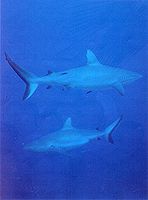 Namena
has everything - soft corals, a spectacular wall and lots of big pelagics.
I saw a minke whale broach here and humpbacks are seen during their migrations.
Namena
has everything - soft corals, a spectacular wall and lots of big pelagics.
I saw a minke whale broach here and humpbacks are seen during their migrations.
Ira. Ira is presumably short for irate, which is what Ira gets when he isn't fed. On one of our Nigali passage dives Ira stole and ate a plastic bag which won't have been good for his digestion .
Other highlights include the Beqa lagoon, and "Kansas", a night dive site in Namena lagoon. Here every nook and cranny is occupied by sleeping parrot fish of every colour and hue. Namena has everything - soft corals, a spectacular wall and lots of big pelagics. When I say big, I mean big. I saw a minke whale broach here and humpbacks are seen during their migrations.
No article about Nai'a would be complete without a mention of the food and the crew. The food is superlative and there is a lot of it. Catching it isn't difficult. One evening I was sitting in the salon above the water talking to Rob when I got hit in the ear by a 30cm barracuda. This isn't included in the price of the cruise and I was sworn to secrecy "in case everybody wanted one".
Memories of fiery sunsets over Viti Levu, friendly Fijian staff, crazy fire walkers, fellow guests with similar interests...
The crew are gems. Nothing is too much trouble for them and they gladly welcome you into their midst to share a few bowls of kava (a social and ceremonial drink) and strum out some tunes on ukelele or guitar. A large tip for the crew's Christmas fund is very much in order here.
While the diving is superb it would be sad to leave Fiji without sharing in the culture of these hospitable people. For many in our group the highlight was a visit to Sawaieke village on Gau. They laid on a Fijian meke (dancing and singing) for us. By the time we boarded the skiffs to return to Nai'a for the overnight journey to Suva the ten days had passed far too quickly. We'd learned a lot about the coral reef, about Fiji, about each other and even about ourselves. One client got it just right in the visitors book... "Ten days that changed my life."
Try the Fiji experience, but be warned it is extremely addictive .
Paddy Ryan is a freelance photographer/writer and environmental consultant specialising in nature and the tropical Pacific. He has written three books, including 'Fiji's Natural Heritage' and 'Snorkeller's Guide to the Coral Reef'.